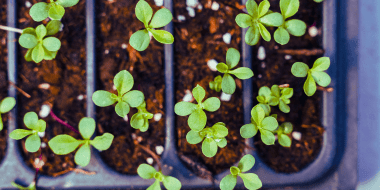What? Recycle less, you say? That's right! When curbside recycling was introduced, it took some getting used to. But it quickly became habit — it feels good to avoid sending recyclables to landfill! But recycling also gives us a false sense of success. In 2018, National Geographic reported that 91% of "recycling" never actually gets recycled! Yes, it's definitely better than landfill, but even better is to reduce your amount of waste overall — and that includes recyclables and even compost.
Tips to reduce recycling
These are just a few simple things you can do at home and during everyday shopping to not only save the environment, but save yourself a decent chunk of change in the process. Win-win!
Buy in bulk
Check out the bulk section of your nearest health food store, and bring your own containers with you. Have the empty containers weighed (put a piece of masking tape on the lid and bring a pen to record the weight) and after filling the containers, the cashier can then subtract the recorded weight from the filled weight so you're just paying for the contents. Some stores give a discount when you bring your own container. Make or buy your own produce bags that you can reuse and wash just like the large grocery bags.
Reduce single-use plastic packaging
These are so tempting as a quick snack-on-the-go or to make packing lunch easier. But the plastic wraps and containers create unnecessary waste (and may contain BPA, a hormone disruptor which can leach into food). Instead, have snacks in small reusable containers ready to grab as you head out the door. I kept a container of trail mix in the diaper bag at all times, for example. And the kids' snack cupboard has small containers prefilled with raisins, crackers, cookies, etc. that are easy to grab-and-go. It takes less than a minute to fill a few days' worth of snack packs — less time than it takes to take the recycling out!
What to do with glass jars
Jars are great for storing leftovers, freezing stock, and taking salads and smoothies to work. They also make great baby food containers (you can freeze and reheat right in the jar without dealing with plastic problems). It'll save you having to buy other food storage solutions, and you've already paid for it with the cost of the food that came in them — seems silly that we throw them away, doesn't it?
Homemade cleaning and beauty products
Making your own products and food from scratch is a great way to reduce packaging waste. Rinse and reuse spray bottles, cream and lotion tubs, diaper cream tins, etc. as you finish them so you have containers on hand to store homemade versions. Cleaning products are really guilty of coming with lots of waste. If you’re new to DIY like I was, I recommend starting with these simple and effective cleaners and reusing the old containers and sprayers.
Reducing waste, including recyclables, saves you money, and is good for the environment. It’s something you can involve the kids in too — encourage arts and crafts using recyclables, colouring on both sides of the paper. It can be hard for kids to understand why they don’t have the same shiny foil packages of snacks in their school lunches, but if you explain the reasons why you choose to use reusable containers, they’ll probably be happy they aren’t contributing to the landfill.
*Originally published May 24, 2016









